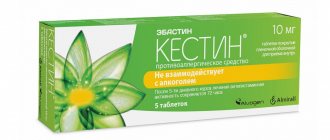Use of the drug Azathioprine
The dose is selected individually. To prevent transplant rejection, a loading dose of up to 5 mg/kg body weight is prescribed orally in 2–3 doses for 1–2 months; then switch to maintenance treatment at a dose of 1–4 mg/kg per day orally. For diffuse connective tissue diseases, it is prescribed orally at an average daily dose of 2–2.5 mg/kg; for chronic active hepatitis, the daily oral dose is 1–1.5 mg/kg. For rheumatoid arthritis, lower doses of azathioprine may be effective. The treatment is long-term. When azathioprine is discontinued, the dose should be reduced gradually.
Azathioprine 50 mg 50 pcs. tablets moskhimfarmpreparaty im. on the. Semashko
pharmachologic effect
Immunosuppressive drug.
Composition and release form Azathioprine 50 mg 50 pcs. tablets moskhimfarmpreparaty im. on the. Semashko
Tablets - 1 tablet:
- Active substance: azathioprine - 50 mg;
- Excipients: gelatin - 0.26 mg, potato starch - 10 mg, lactose monohydrate (milk sugar) - 38.24 mg, crospovidone (polyplasdone XL-10) - 0.5 mg, calcium stearate - 1 mg.
10 tablets are placed in a blister pack made of polyvinyl chloride film and aluminum foil.
5 blister packs along with instructions for use are placed in a cardboard pack.
Description of the dosage form
Tablets: light yellow or light yellow with a greenish tint, round, flat-cylindrical, chamfered.
Characteristic
An immunosuppressant from the antimetabolite group.
Directions for use and doses
Inside.
Adults
Transplantation
Up to 5 mg/kg/day on the first day of therapy.
Maintenance dose from 1 to 4 mg/kg/day depending on clinical indications and hematological tolerability.
Even when low doses are used, azathioprine maintenance therapy should be continued indefinitely due to the risk of graft rejection.
Other diseases
The initial dose is 1-3 mg/kg/day and should be adjusted within this dose range depending on the clinical effect (which can be obtained after several weeks and months from the start of treatment) and hematological tolerability.
If a therapeutic effect is obtained, then it is necessary to reduce the maintenance dose to the minimum level that maintains the effect obtained. If clinical effect is not achieved within 3 months, azathioprine should be discontinued. However, for inflammatory bowel diseases, treatment should be carried out for at least 12 months, and the therapeutic effect can be achieved after 3-4 months.
The maintenance dose can range from less than 1 mg/kg/day to 3 mg/kg/day and is determined by the disease, individual patient response, and hematologic tolerability.
Use in elderly patients
Experience with azathioprine in elderly patients is limited. Minimum dosages of the recommended dosage range should be used. Particular attention should be paid to monitoring hematological parameters and reducing the maintenance dose to the minimum acceptable to maintain the therapeutic effect.
Children
Transplantation
See dosages for adults during transplantation.
Other diseases
See dosages for adults for other diseases.
Kidney/liver failure
In patients with renal and/or hepatic impairment, the minimum dose in the therapeutic range should be used.
Pharmacodynamics
Azathioprine is a thiol derivative, a competitive antagonist of hypoxanthine, similar in chemical structure and biological action to purine bases; has immunosuppressive and cytostatic effects.
When involved in metabolic reactions, it disrupts the synthesis of nucleic acids, competes with hypoxanthine and guanine for hypoxanthine guanine phosphoribosyltransferase, which converts purinetol into thioinosinic acid (TIA). TIC inhibits a number of reactions involving inosinic acid (IC), including the conversion of IC to xanthine and adenylic acids. During TIC methylation, a metabolite is formed that blocks glutamine-5-phosphoribosylpyrophosphate aminotransferase, an enzyme that initiates the pathway of purine ribonucleotide synthesis. Due to the loss of the ability of cells to form TECs, the development of resistance of tumor cells to azathioprine is possible.
The immunosuppressive effect is due to hypoplasia of lymphoid tissue, a decrease in the number of T-lymphocytes, impaired Ig synthesis, the appearance of atypical phagocytes in the blood and suppression of cell-mediated allergic reactions. Compared to mercaptopurine, the immunosuppressive effect is relatively stronger (with less cytostatic activity). In large doses (10 mg/kg) it inhibits bone marrow function, suppresses granulocyte proliferation, and causes leukopenia.
Pharmacokinetics
Absorption: Azathioprine is well absorbed from the upper gastrointestinal tract. Time of onset of Cmax is 1-2 hours.
Distribution: association with plasma proteins is low. Penetrates the placenta and accumulates in breast milk. Average therapeutic doses create very low concentrations in the blood (less than 1 mcg/ml), which do not correlate with the severity and duration of the effect.
Metabolism: after the “first pass” through the liver, it is metabolized into mercaptopurine (active metabolite), quickly absorbed from the blood by tissues. Oxidation and methylation - in the liver, erythrocytes with the formation of a pharmacologically inactive metabolite (6-thiouric acid) under the influence of xanthine oxidase. The half-life T1/2 is 5 hours.
Elimination: Azathioprine is primarily excreted as 6-thiouracil acid in urine. 1-methyl-4-nitro-5-thioimidazole is also detected in urine in small amounts. Only a small amount of the administered dose of azathioprine is excreted unchanged in the urine. It is removed during hemodialysis and quickly disappears from the bloodstream.
Indications for use Azathioprine 50 mg 50 pcs. tablets moskhimfarmpreparaty im. on the. Semashko
Prevention of rejection during kidney transplantation, rheumatoid arthritis, chronic active hepatitis, systemic lupus erythematosus, dermatomyositis, periarteritis nodosa, acquired hemolytic anemia, idiopathic thrombocytopenic purpura, pyoderma gangrenosum, psoriasis, Crohn's disease, ulcerative colitis, myasthenia gravis, pemphigus, Reiter's syndrome, radiation dermatitis, pseudohypertrophic myopathy.
Ineffectiveness and contraindications to the prescription of glucocorticosteroids or the need to reduce their dosage (in patients with side effects from their use and/or a high risk of their development).
Azathioprine is used as monotherapy or in combination with corticosteroids and/or other immunosuppressants.
Contraindications
Hypersensitivity, inhibition of hematopoiesis (hypoplastic and aplastic anemia, leukopenia, lymphopenia, thrombocytopenia), liver failure, pregnancy, lactation.
Application Azathioprine 50 mg 50 pcs. tablets moskhimfarmpreparaty im. on the. Semashko during pregnancy and breastfeeding
Azathioprine is contraindicated in women who are pregnant or planning to become pregnant in the near future without a thorough risk-benefit assessment.
Azathioprine is teratogenic in both men and women. As with any cytotoxic chemotherapy, adequate contraception should be recommended if either partner is receiving azathioprine.
There are reports of preterm birth and low birth weight of infants born to mothers receiving azathioprine, especially in combination with corticosteroids. Spontaneous abortions have been known to occur due to the use of azathioprine by either parent.
Azathioprine and/or its metabolites were found in low concentrations in fetal blood and amniotic fluid in women receiving azathioprine.
Leukopenia and/or thrombocytopenia have been identified in neonates whose mothers took azathioprine during pregnancy. Increased attention should be paid to monitoring hematological parameters during pregnancy.
Azathioprine is contraindicated during lactation. 6-MP is found in the breast milk of women receiving azathioprine.
special instructions
Monitoring
There is a potential risk of toxic complications when using azathioprine, so it can only be prescribed if the patient receives adequate monitoring throughout therapy.
It is suggested that during the first 8 weeks of therapy, a complete blood count, including platelet determination, should be performed weekly, or more frequently if a high dose of the drug is used or the patient has severe renal and/or hepatic impairment. In the future, blood tests can be monitored less frequently, but a complete blood count should be repeated monthly or at least at intervals of no more than 3 months.
Patients receiving azathioprine should be instructed to immediately report any infections, unexpected bruising, bleeding, or other signs of bone marrow suppression.
Some individuals with a congenital deficiency of the enzyme, thiopurine methyltransferase (TPMT), may be hypersensitive to the myelosuppressive effects of azathioprine and be prone to rapidly developing bone marrow depression after initiation of azathioprine treatment. This problem may be exacerbated by combination with drugs that suppress TPMT (olsalazine, mesalazine or sulfasalazine).
Renal and/or liver failure
The toxicity of azathioprine is suspected to be increased in renal failure, but controlled studies have not confirmed this assumption. However, dosages at the lower end of the dosage range and close monitoring of hematologic parameters are recommended. If hematological toxicity develops, doses should be reduced.
Caution is necessary when prescribing azathioprine for liver failure, and regular complete blood counts and liver tests should be performed. In some patients, the metabolism of azathioprine may be impaired and, therefore, the dose should be reduced if signs of hepatic and hematological toxicity develop.
Limited evidence suggests that azathioprine is unfavorable for patients with hypoxanthine guanine phosphoribosyltransferase deficiency (Lesch-Nychen syndrome) and azathioprine should not be recommended for them.
Mutagenicity
Chromosomal abnormalities have been found in men and women receiving azathioprine. But the role of azathioprine in their occurrence is difficult to assess.
Chromosomal abnormalities that resolve over time have been found in children of patients receiving azathioprine. Except in extremely rare cases, they showed no obvious physical signs of these disorders.
There is a synergistic effect of azathioprine and long-term ultraviolet irradiation in patients taking azathioprine.
Effect on reproductive function
Reduction of renal failure as a result of kidney transplantation followed by azathioprine was accompanied by increased reproductive function in both male and female transplant recipients.
Carcinogenicity
Patients taking azathioprine have an increased risk of developing lymphomas and other malignancies, mainly skin cancer. The risk is associated with the intensity and duration of immunosuppressive therapy rather than with the use of a specific drug. It has been reported that dose reduction or discontinuation of an immunosuppressant may cause reversal of lymphoma.
Patients receiving multiple immunosuppressive medications are at risk of overimmunosuppression and should be treated with the lowest effective drug doses. As is common practice in patients at increased risk of skin cancer, sun exposure and ultraviolet exposure should be limited by wearing protective clothing and using high-protection sunscreens.
Impact on the ability to drive vehicles and operate machinery
No data. However, it is impossible to predict impaired ability to drive a car/machines based on the pharmacokinetics of azathioprine.
Overdose
Symptoms: dyspepsia, pancytopenia, increased activity of “liver” transaminases, hyperbilirubinemia. Ulceration of the pharyngeal mucosa, bruising and bleeding are the main symptoms of bone marrow depression resulting from azathioprine overdose, which peak after 9-14 days of use. Their appearance is more likely in chronic than in acute single overdose. A patient is reported to have taken a single overdose of 7.5 g of azathioprine. The immediate toxic effects of this overdose were nausea, vomiting and diarrhea, followed by mild leukopenia and mild liver dysfunction. Recovery was incomplete.
Treatment: gastric lavage. There is no specific antidote. Follow-up with hematological monitoring is necessary to provide prompt assistance in the event of adverse reactions. The effectiveness of dialysis is unknown, although azathioprine is partially eliminated by hemodialysis.
Side effects Azathioprine 50 mg 50 pcs. tablets moskhimfarmpreparaty im. on the. Semashko
The incidence of side effects when using azathioprine varies depending on the pathology that serves as the basis for its use.
Classification of undesirable side reactions by frequency: Very common: ≥ 1/10 prescriptions; Frequent: ≥1/100 —
Infectious and parasitic diseases - Uncommon: viral, fungal and bacterial infections.
Benign, malignant and unspecified neoplasms (including cysts and polyps) - Rare: neoplasms including lymphomas, skin cancer, acute myeloid leukemia and myelodysplasia.
The risk of developing lymphomas and other malignancies, mainly skin cancer, increases in patients receiving immunosuppressive therapy; especially in organ transplant recipients receiving aggressive therapy. Therefore, such therapy should be maintained at the minimum dosage level necessary to maintain its effectiveness. The increased risk of developing lymphomas compared with the general population in patients with rheumatoid arthritis taking immunosuppressive drugs is due, at least in part, to the disease itself.
Blood and lymphatic system disorders - Very common: bone marrow depression, leukopenia; Common: thrombocytopenia; Uncommon: anemia; Rare: agranulocytosis, pancytopenia, aplastic anemia, megaloblastic anemia, erythroid hypoplasia.
Azathioprine can cause reversible dose-dependent bone marrow depression, most commonly manifesting as leukopenia, sometimes anemia and thrombocytopenia, and rarely agranulocytosis, pancytopenia and aplastic anemia. This has been observed in patients with thiopurine methyltransferase enzyme deficiency, renal and hepatic impairment who are predisposed to bone marrow toxicity, and in patients in whom azathioprine dosage reduction has failed when co-administered with allopurinol.
Reversible dose-dependent increases in mean blood cell volume and erythrocyte hemoglobin content occurred with azathioprine.
Immune system disorders - Uncommon: hypersensitivity reactions.
When using azathioprine, some clinical manifestations of idiosyncrasy sometimes develop as part of the hypersensitivity syndrome. These include general weakness, dizziness, nausea, vomiting, diarrhea, fever, exanthema, rash, myalgia, arthralgia, renal dysfunction and hypotension.
In many cases, analysis has shown that these symptoms are related to azathioprine. Immediate discontinuation of azathioprine and, if necessary, administration of supportive hemodynamic therapy led to recovery in most cases.
If hypersensitivity reactions to azathioprine develop, the possibility of continuing further therapy should be assessed individually.
Respiratory, thoracic and mediastinal disorders - Very rare: reversible pneumonitis.
Gastrointestinal disorders - Common: nausea; Uncommon: pancreatitis; Rare: colitis, diverticulitis occur during organ transplantation; with inflammatory bowel diseases - intestinal perforation, severe diarrhea.
A small number of patients experience nausea when first using azathioprine, which is relieved by taking the drug after meals.
Serious complications, including colitis, diverticulitis, and intestinal perforation, have been described in organ transplant recipients receiving immunosuppressive therapy. However, the etiology of these complications has not yet been established and they may be caused by high doses of corticosteroids. Severe diarrhea has occurred in patients receiving azathioprine for inflammatory bowel disease. The possibility of dose-related exacerbation of symptoms in these patients must be taken into account.
Histologic manifestations such as hepatic sinus dilatation, hepatic purpura, veno-occlusive disease, and nodular regenerative hyperplasia partially or completely resolve with discontinuation of azathioprine.
Skin and subcutaneous tissue disorders - Rare: alopecia.
In many cases, hair loss stops despite continued therapy. The relationship of this symptom to azathioprine has not been determined.
Drug interactions
Allopurinol/oxypurinol/thiopurinol
The activity of xanthine oxidase is inhibited by allopurinol, oxypurinol and thiopurinol, which is accompanied by a decrease in the conversion of biologically active 6-thioinosinic acid to biologically inactive 6-thiouracil acid. When allopurinol, oxypurinol and/or thiopurinol are administered concomitantly with 6-MP or azathioprine, the dose of the latter should be reduced by one quarter of the original dose.
Neuromuscular blockers
Azathioprine may enhance the neuromuscular blockade caused by depolarizing drugs (succinylcholine) and may reduce the blockade caused by non-depolarizing drugs (tubocurarine). The strength of these interactions varies considerably.
Warfarin
Suppression of the anticoagulant effect of warfarin has been reported when administered with azathioprine.
Cytostatic/myelosuppressive drugs
If possible, concomitant use of cytostatic drugs or drugs with myelosuppressive effects, such as penicillamine, with azathioprine should be avoided.
There is clinical evidence of the interaction of azathioprine and cotrimoxazole with the development of hematological disorders.
A description of a case is provided that suggests a connection between hematological disorders and the simultaneous use of azathioprine and captopril.
There is speculation that cimetidine and indomethacin may enhance the myelosuppressive effect of azathioprine when administered concomitantly.
Aminosalicylates
Aminosalicylic derivatives (olsalazine, mesalazine or sulfasalazine) inhibit the TPMT enzyme in vitro and should be used with caution in patients receiving azathioprine therapy.
Other interactions
Furosemide in vitro interferes with the metabolism of azathioprine by liver tissue. The clinical significance of this interaction is unknown.
Vaccines
The immunosuppressive activity of azathioprine may cause an atypical or potentially adverse response to live vaccines, and live vaccines are therefore theoretically contraindicated in patients taking azathioprine.
Decreased response to killed vaccines is likely and has been observed with hepatitis B vaccine in patients receiving combination therapy with azathioprine and corticosteroids.
Standard therapeutic doses of azathioprine have not been shown to cause an adverse response to multivalent pneumococcal vaccine, as assessed by mean anticapsular-specific antibody concentrations.
Side effects of the drug Azathioprine
Possible secondary infections, leukopenia, thrombocytopenia, anemia, development of megaloblastic erythropoiesis and macrocytosis, nausea, vomiting, anorexia, skin rash, arthralgia, myalgia, drug fever, cholestatic hepatitis. Pancreatitis, peptic ulcers, gastrointestinal bleeding, intestinal necrosis and perforation have been reported in transplant recipients. There are isolated reports of side effects such as acute renal failure, hemolytic anemia, acute pulmonary diseases, and meningeal reactions.




